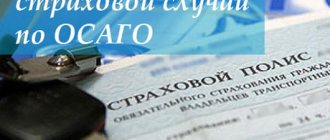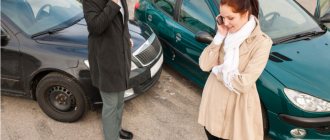What is CASCO?
CASCO is a specialized type of insurance protection provided as a result of concluding a voluntary insurance contract for structural damage to a car.
Unlike compulsory motor liability insurance, this type of insurance is not mandatory, therefore it is less regulated by law. The process of obtaining insurance is very sensitive to the nature of the insurance claim. If the conditions are not met, in the vast majority of cases, the insurer will refuse, and payment under CASCO insurance in case of an accident will not be made. This should be taken into account by all drivers who believe that they are insured against unforeseen circumstances if they have a policy.
Important! CASCO is a generally accepted insurance term, but is not an abbreviation for the service. When traveling abroad, keep in mind that similar insurance services may be provided under a different name.
Insured events usually include several categories of incidents:
- theft of parts, assemblies and components of a car;
- theft of an insured vehicle;
- damage from hooliganism;
- violation of the integrity or damage to the vehicle resulting from natural factors;
- accidents and other traffic incidents that led to damage.
As you can see, the CASCO service involves directly insuring individual parts and components of vehicles. The list of cases in which CASCO payments are made is usually reflected in the contract.
What is CASCO and what does it protect against?
Unlike compulsory MTPL vehicle insurance, a comprehensive insurance contract is concluded at the discretion of the driver. The list of insurance risks for it is much wider and includes almost all unpleasant situations that can happen to the car. In particular, these are:
- collision with other vehicles (regardless of whether the policyholder is at fault for the accident);
- falling or tipping over while driving;
- damage by objects lying on the road or flying out from under the wheels of other cars;
- theft or theft of a vehicle or its individual elements;
- accidental or deliberate actions of third parties, be it a scratch left by children playing in the yard or an act of vandalism;
- hitting a parked car with another vehicle;
- fire or explosion;
- disaster;
- man-made accident;
- falling of all kinds of objects - from icicles to parts of buildings.
There are also a number of other risks, including damage to electrical wiring by rodents. The insurance company will even reimburse the cost of tow truck services if the car needs to be towed after an accident.
In addition, additional insurance conditions can be added to the comprehensive insurance policy: for example, extending the coverage of the contract to the territory of other countries or including insurance against theft and damage to wheels.
All insurance cases under CASCO
Dear readers!
Our articles talk about typical ways to resolve legal issues, but each case is unique. If you want to find out how to solve your particular problem, please contact the online consultant form
It's fast and free!
Or call us by phone (24/7):
If you want to find out how to solve your particular problem, call us by phone. It's fast and free!
What else to read:
- My car was scratched in the yard, what should I do?
- Europrotocol 2021
- How to get money instead of repairs under compulsory motor liability insurance: a detailed review
+7 (495) 980-97-90(ext.589) Moscow,
Moscow region
+8 (812) 449-45-96(ext.928) St. Petersburg,
Leningrad region
+8 (800) 700-99-56 (ext. 590) Regions
(free call for all regions of Russia)
When concluding a contract, it is better to immediately clarify how to receive a CASCO payment from a specific insurance company. Despite the same general rules, it is better to follow the instructions of the specific insurance company with which the contract was concluded.
Before signing a contract, it is advisable to consult with an auto lawyer or buy an insurance policy on the recommendation of a specialist who is well aware of the peculiarities of the insurance market in your city.
The list of insured events and the specifics of providing financial assistance must be recorded in the contract. In general, a CASCO agreement may cover the following events:
- All types of robbery and the consequences of these actions: theft of a vehicle or loss of individual spare parts.
- Damage to a vehicle as a result of the actions of strangers.
- Damage caused by natural disasters and disasters.
- Falling off the road (into a ravine, abyss).
- Damage to vehicle components and components as a result of road accidents.
- Loss of vehicle performance regardless of the circumstances.
Unlike compulsory motor liability insurance, the driver must receive compensation under the CASCO policy even if he was at fault in the accident. However, this does not always happen; insurers under this type of policy also try to write off the damage to the guilty party. Moreover, for this purpose, tricks are used in violation of registration regulations. These are common and main reasons for refusal to pay CASCO.
What applies to them
Under a CASCO agreement, the occurrence of an event obliging the insurance company to cover damage caused to vehicles may be recognized as an insured event.
The terms of coverage must be discussed in the insurance contract, which must be drawn up in compliance with certain rules and regulations of current legislation.
An insured event is determined by the risk that is included in the insurance coverage of the CASCO policy under the insurance contract.
They are divided into two groups:
- damage is manifested in the risk of damage, complete destruction of the car as a result of an emergency situation on the roads, leading to an accident. These include collisions of vehicles, their collision with each other, their overturning, falling into a ditch, ravines, collision with another vehicle when it is parked;
- theft occurs in the case of theft, robbery, illegal taking, without intent to steal.
The insurance company individually determines the risks from which types of risks it is ready to protect its clients. However, as practice shows, the set of risks is standard. It depends on the package purchased by the client, which can be either extended or reduced.
When concluding a CASCO agreement, the policyholder is given the following:
- a policy confirming the rights of the car owner;
- CASCO insurance rules, the content of which explains the procedure for action in the event of an event that can be recognized as insurance;
- a memo to the policyholder containing information about the insurance company and contact details.
What to do in case of an accident and CASCO insurance
If you have a CASCO policy, when an insured event occurs, it is important to comply with the requirements for its registration and the corresponding actions:
- The driver is required to stop immediately after the event.
- After stopping, you need to turn on the hazard lights and set the appropriate traffic signals.
- After this, you need to contact the traffic police and call a patrol car to the scene of the incident.
- At the same time, you need to call the insurer back at the phone number specified in the policy leaflet and describe the situation (you should also contact an auto lawyer for advice).
- It is advisable to collect photographic evidence from the scene of the incident.
Please note that you can receive compensation under the CASCO policy of the culprit or under your own contract. Compensation is provided once. Payment under CASCO without a certificate of an accident is possible only if compensation is received for one of the described insurance cases that do not relate to road accidents.
A certificate of an accident is not a comprehensive document; a post-accident diagram drawn up by the State Traffic Safety Inspectorate is also required. This is the starting point in resolving controversial issues when receiving compensation.
It is better to carry out any conversations with participants in events on the road together with a lawyer and a motor vehicle lawyer. Try to remain silent until your representatives arrive, except when assisting victims.
Video on the topic
What applies to insurance events?
Almost every insurance company has a comprehensive insurance policy with individual conditions and features, so the list of insured events may differ from company to company. However, almost all comprehensive insurance policies cover categories of risks such as those associated with a traffic accident and those not associated with them.
As a result of an accident
Insurance companies and insurance rules define a traffic accident as all situations on the roads that lead to damage or complete loss of the car. Some insurers sell comprehensive insurance for road accidents for the same set of risks as compulsory motor liability insurance. Others waive the full list to reduce the likelihood of their losses and include a limited number of risks in the program. The most common are:
- Accidents on all types of roads;
- Collisions in the courtyards of residential buildings;
- Accidents in parking lots and parking lots;
- Causing damage during the operation of a tow truck;
- Damage to a car by road workers.
The list of risks associated with road traffic accidents may change. It is indicated in the contract along with a list of spare parts and machine structures that may be subject to replacement or repair under comprehensive insurance in the event of an accident. The contract will indicate a list of cases when, after an accident, the policyholder will not be able to receive compensation (drug/alcohol intoxication, lack of a driver’s license, etc.)
No accidents
A comprehensive insurance case without an accident is any situation not related to the movement of the vehicle. Depending on the program, a voluntary insurance policy can protect against the following risks:
- Damage from natural disasters;
- Damage from illegal actions of other persons;
- Damage caused by other persons due to negligence;
- Damage from collisions with animals/birds;
- Damage from falling heavy objects;
- Damage from spontaneous combustion;
- Cases of theft, theft and robbery.
Also, comprehensive insurance contracts provide for cases that may cause refusal of payments even if an insured event occurs. The most common non-insurance cases under comprehensive insurance include theft of a car in which a passport, car registration certificate or ignition keys were left. They will not pay the full amount of compensation for minor damage with minimal damage, if a policy with a deductible is issued, as well as for intentional damage to the car in order to obtain compensation.
How to file an accident under CASCO
First of all, when registering incidents, you need to pay attention to the protocol. Under no circumstances should you sign it in a state of stress; it is better to do this after consulting with your lawyer. After the incident, the traffic police issues a fine for the accident, a receipt for payment and the resolution itself must be provided in order to receive payment under CASCO. Next, fill out a free form statement about the incident to receive compensation.
Please note that only in some cases can you count on violating the registration procedure and drawing up a notice at the scene of the incident. Most often this leads to refusal of payment. When you can receive compensation and the procedure itself, the insurance inspector will clarify. The deadlines for payments under CASCO are reflected in the contract.
If you still want to draw up a notice, you can do it yourself. In some cases, the insurer may satisfy the request without a complete package of documents. In this case, it is necessary to accurately describe the circumstances, and also include evidence of the incident and the injuries sustained. You will need to bring in witnesses.
Under what circumstances does CASCO not pay?
The policy has a number of restrictions - insurance companies may not recognize your case as insured if:
- At the time of the incident, the car was not driven by the owner or the driver included in the policy.
- The driver was drunk or under the influence of substances (medicines prohibited from driving after taking them, drugs, etc.).
- At the time of the incident, the car was located outside the official road and adjacent infrastructure.
- The driver had an expired license or no license at all.
- There was negligence - the safety precautions for driving a car, the necessary algorithm of actions when braking or moving, etc. were ignored.
- Traffic rules were violated.
- The car was impaired and should not have been used, but the driver did it anyway.
Also, payment may be refused if the incident turned out to be premeditated - you damaged the car on purpose in order to receive a monetary reward under the insurance policy.
In addition, you must comply with the contract. If you violated any of the regulations specified in the contract with the insurance company, you may not receive payment. Documents not filled out correctly or not fully provided will also slow down the decision of the Investigative Committee regarding your case.
How is it processed according to the Europrotocol?
Another option for registering an accident is the Europrotocol. When filling out the front part, both participants must be present; any pens can be used for this. The reverse side is filled in after the events. To eliminate various situations with inconsistency of forms, it is better to use the forms provided by the insurance company.
The protocol must indicate the following data:
- damage and list of damaged units and components;
- description of the damage in financial terms;
- accident diagram drawn up by the traffic police;
- circumstances of the accident;
- personal data of participants with contacts and addresses;
- name of the insurer;
- participants' driver's license numbers;
- driver contacts;
- personal data of the person who was driving during the accident of a car with a CASCO policy;
- registration certificate and VIN;
- brief description of participating vehicles (make and model);
- data from road service inspectors;
- personal (passport) data of witnesses;
- information about the medical examination of participants;
- presence of wounded (dead);
- date and time of the accident;
- data about the accident site.
Please note that the maximum payment under CASCO will be made if the list of damages is correctly described and the total damage is assessed in financial form.
The procedure for receiving payment under CASCO
To receive payment in case of car damage, you must comply with the following rules:
- It is important to call the traffic police immediately after the incident. Depending on the nature of the incident, other services may be called: the Ministry of Emergency Situations, the police. This is necessary to record all the circumstances of what happened;
- until the fact of the incident is registered, the vehicle cannot be moved or moved;
- signing any agreements with other participants in an accident should be done with caution, as this may become a reason for refusal to provide compensation;
- When drawing up a protocol, a traffic police officer should indicate all the features of the incident; the protocol should be as detailed and accurate as possible.
If the moment of the incident was recorded on road surveillance cameras, it is necessary to indicate this. It is best to immediately write down the number and name of the camera.
After reporting an accident, it is important:
- contact the insurance company as quickly as possible and report the occurrence of an insured event;
- along with the application, provide all required documents, keeping copies with you;
- The damaged vehicle is sent for examination. It is advisable to immediately find out all the features of its implementation;
- After registering the appeal with the insurer, you should receive its number and constantly monitor the progress of the consideration. It is not recommended to wait until the end of the term; it is better to remind yourself in advance.
After this, the insurance company must give an opinion on the possibility of providing compensation, as well as its amount.
Contacting the insurance company after an accident under CASCO
When contacting an insurance company after an accident, it is better to comply with the requirements of the contract or instructions provided by the insurance agent. Before concluding a contract, it does not hurt to compare the contract data with the legal requirements. If regulatory violations of the contract clauses are noticed later, payments can be obtained through the court. However, the likelihood of such an outcome is not so high.
You must notify the insurance company about the event within 3 days, preferably on the day of the incident!
Insured event without an accident
The owner of a vehicle has the right to insure it against other types of risks as a result of which insured events arise related to its damage as a result of:
- fire, unauthorized combustion, uncontrollable combustion;
- explosion, regardless of the reasons;
- natural disaster caused by natural disasters. For example, earthquake, hurricane wind. To receive the due payment, you must submit to the insurance company identification documents issued by the meteorological service;
- hit by stones of various diameters, their falling, falling snow, tearing off ice;
- illegal actions committed in relation to vehicles by third parties;
- damage to the body due to involuntary exposure to animals.
What documents are needed
When contacting an insurance company, the following documentary basis is required:
- accident report (copy) and traffic police certificate;
- accident diagram;
- fine decision;
- independent notification (with a simplified version);
- STS and PTS;
- driver's license;
- statement;
- CASCO policy and Europrotocol;
- agreement on the amount of payments;
- passport;
- court decision (if any);
- inspection certificate;
- medical discharge in the presence of wounded and casualties.
What to do if an adverse event occurs
If there has been an insured event, then it is necessary to focus on the rules and follow its requirements in order to receive the due payment without unnecessary “bureaucracy”.
In accordance with the above document it is necessary:
- immediately notify the insurance company about the insured event, provide contact details, insurance contract number, car details;
- timely submit an application to the insurance company, filled out on a special form, and attach the necessary documents to it;
- provide the damaged vehicle for inspection on the day of submission of the application, and take part in it. If it is impossible to transport the vehicle to the designated place, it is carried out in the place where the person authorized by the insurance company is located;
- As soon as possible, you must submit an application to the company where the CASCO policy was purchased. In it, describe in detail the event that occurred, ask for payment to be made in accordance with the terms of the contract, provide links to the norms of legislative acts, provisions enshrined in the Insurance Rules.
The wait for a decision made by the insurance company, according to current legislation, is 20 calendar days.
At the end of the established period, she is obliged to give a positive answer or refuse to satisfy the demands of the insured, which must be reasoned.
If there is no response from the insurance company, you will need to call the Direct Claims Adjustment Department or the hotline to find out.
If there is no certificate of an accident
If there is no certificate of an accident, you can receive payments in connection with damage to the car. However, if the car was clearly involved in an accident, the insurance agent may insist on contacting the traffic police in order to eliminate the criminal trace of the incident.
For other consequences, you can use other compensation options reflected in the contract. To do this, you should contact the service and an experienced auto lawyer.
What is required to file damages for an accident:
- description of the scene of the incident, including a description of the markings and driving directions;
- indicate the braking distance at the scene of the accident and its location relative to other vehicles and obstacles;
- information about the insured car;
- driver data;
- information from two witnesses.
What cases are considered insured?
A traffic accident is one of the typical insurance events covered by comprehensive insurance. There is always at least one car involved in an accident. At the same time, he must be on the road or participate in traffic. Damage caused by another vehicle while parked is also considered a traffic accident.
What to do in case of an accident?
If an accident occurs, you need to adhere to the following action algorithm:
- Stop, turn on your hazard lights and put up a warning triangle. Do not move the vehicle or objects that are related to the accident.
- If two cars were involved in an accident, the drivers of the vehicles have compulsory motor insurance, no harm was caused to health or life, and no property other than two cars was damaged, then the accident can be registered under the European Protocol - without the traffic police.
- If more than two cars were involved in an accident or people were injured, then you must call the traffic police and an ambulance (if necessary).
- Take video or photographs of the damage to the vehicle and the scene of the accident. Try to find witnesses to the accident. The more evidence you have, the easier and faster it will be to receive compensation.
- Contact your insurance company. Call the hotline for free at any time. Specialists will tell you how to file an insurance claim and advise you on the procedure and timing for receiving compensation.
How to file a traffic accident?
Registration of an accident takes place according to two main scenarios:
- If the incident complies with the conditions for registration of the Euro Protocol, fill out a paper Notification of an Accident. This document consists of two columns: you fill out one of them, the second participant in the accident fills out the other. When recreating the picture of an accident, use standard accident diagrams and instructions from the Russian Union of Auto Insurers.
- In other cases, you need to call a traffic police officer to the scene of the accident or go to the nearest police department or traffic police post yourself (with the permission of the officer who answered the call). The traffic police officer will issue a document indicating the list of damaged parts of the car and property, a protocol on the accident, as well as a resolution or determination drawn up for the person who violated the traffic rules. These documents will be useful to you when applying for a refund.
If the accident happened in a parking lot
Situations often arise when the car received scratches, chips and dents while driving in a parking lot, i.e. when the driver himself damaged the car.
In the event of an accident in a parking lot, proceed as follows:
- Try to find video footage of the incident. It is possible that surveillance cameras or video recorders of nearby cars recorded the moment the car was damaged.
- Try to find witnesses to the accident and write down their phone numbers.
- Contact the traffic police if your car was damaged as a result of hitting an obstacle or colliding with another car.
Traffic police officers will draw up a report with which the driver can subsequently go for insurance compensation. It is important not to miss the deadline for contacting the insurance company: 10 days are allotted for this.
How is insurance paid?
You can usually receive a refund immediately after payment limits have been agreed upon. When submitting a claim, it is better to provide access to the insurer’s specialists to the damaged car. If the driver does not agree with the conclusions of the insurance company and the amount of compensation, an examination is required, but the financial gain for the owner will usually be small. Moreover, it is possible that the insurer will begin to look for reasons for a complete refusal of compensation.
How is the CASCO payment made? You can receive funds at the company’s office, or a payment is made to the victim’s specified account. A targeted payment to the repair contractor is possible, but this happens in rare cases when the client and the insurance contractor initially did not agree on the amount of payments, but came to an agreement through repair work. Such an agreement goes beyond the scope of a standard insurance policy, but in some cases it does occur.
Why can insurance compensation be denied?
Most of the reasons for refusal of insurance compensation are related to the unlawful actions of the policyholder himself:
- driving without a license, under the influence of alcohol or drugs;
- leaving the scene of an accident or refusing a medical examination;
- distortion of information about the incident, concealment of important details;
- driving by a driver who is not listed in the comprehensive insurance policy;
- deliberate failure to take measures that would help avoid the occurrence of an insured event or reduce damage from it;
- use of unsuitable or low-quality spare parts and technical fluids;
- making changes to the design of the car without approval from the traffic police;
- absence of a State Technical Inspection mark if the insured event occurred due to the poor technical condition of the car;
- travel outside public roads;
- violation of safety rules when transporting goods;
- smoking and careless handling of fire;
- violation of towing rules prescribed in the traffic rules;
- opening the hood while driving.
It is important to consider that the insurer will refuse insurance compensation if the problem is caused by poor quality repairs. Therefore, having a comprehensive insurance policy does not eliminate the need to carefully select auto repairmen, giving preference to reliable certified service centers.
Insurance compensation in case of theft will be paid, but in a reduced amount, if the driver left the keys inside the car, or they were lost or stolen, and the owner did not notify the insurance company about this and did not take measures to protect the car. However, penalties can be avoided if you include additional insurance in your policy. With it, the policyholder will receive compensation, even despite his negligence.
If the car is total with CASCO
This question in the language of insurers and drivers means the complete loss of a vehicle and the lack of possibility of restoration. We are talking about the so-called constructive death of the car. Typically, such compensation is included in the standard policy, but before applying for compensation, you should read the clauses of your CASCO agreement. The amount of payments for such damage from the depreciation value is 65–80% and depends on the policy of the insurer.
"Total" can also be recognized as a result of calculation of the cost of restoration by an expert. In this case, it must exceed 400 thousand rubles.
When will the insurance company pay?
The insurance company is obliged to pay compensation within the terms specified in the contract. Typically, the terms of payment under CASCO for total are established by agreement of the parties in agreement with the financial department of the company, the place and time of issue of funds. If the deadlines are critically violated, the victim can receive money by court decision, and he can also claim a penalty if the delay in payments was due to the fault of the insurance company.
On average, the period for a large payment does not exceed 2 weeks.
What CASCO can protect you from
A person who contacts an insurance company and wants to take out a comprehensive insurance policy expects reliable guarantees and is confident that he will receive the compensation due to him in the event of an accident. However, in order not to disappoint their expectations, it is important to understand what comprehensive insurance is and when it arises.
If compulsory motor liability insurance is insurance required by the state, then a comprehensive insurance policy is taken out voluntarily. This creates certain difficulties, since each insurance company has the right to create its own list of covered events and determine various nuances.
Important: Be very careful when drawing up an agreement with an insurance company. It is better to take a sample contract with you and show it to your lawyer. This will protect you from long disputes in the event of an insured event.
The main points by which the insurance company determines the amount of compensation are basically similar. Different companies create different insurance risk packages, so the events covered may vary depending on the package you choose.
All types of contracts can be divided into two categories: theft and damage. What is included in a car theft report? You can receive the maximum payout if your car is stolen or damaged as a result of robbery, theft or assault. All of these actions fall under the category of “theft.”
If the insurance category “damage” is selected in the contract, what events are insured in this situation?
- A traffic accident, regardless of the complexity and severity of its consequences and type.
- Fire (whether caused by external factors, spontaneous combustion or malfunction).
- Subversion.
- Natural disaster (requires a report from meteorologists that such a disaster actually occurred in the area).
- Damage to the vehicle as a result of falling tiles, icicles, lumps of snow or stones.
- Vandalism, theft of individual vehicle parts or damage to paint.
- Damage caused by wild or domestic animals.
After reading the contract, you can be very pleased, because at first glance it is clear that with CASCO insurance you can insure yourself against everything. The onset of an insured event is not the most pleasant feeling for the injured party. And dealing with the insurance company can make you even more nervous. In fact, many insurance companies take all possible measures to reduce the amount of payment stipulated by the contract.
Insurers are especially active in challenging comprehensive insurance claims that are not related to road traffic accidents. It's worth considering when to exercise extra caution and be prepared for excuses from insurance agents.
Will damages be compensated under CASCO if the culprit escaped?
Similarly, as in the previous paragraph, you can answer the current question. Payments under CASCO do not depend on the nature of the driver’s fault, but are paid if there is structural damage to the car. Another thing is that the incident itself and the damage caused to the vehicle must be properly documented. In case of violation of regulations, compensation limits may be lowered. Some insurance companies often resort to such methods of reducing damage.
How to use CASCO without an accident if the insurer underestimates the amount of payments or does not want to pay
If the insurer tries to underestimate the amount of payments, the motorist should conduct an examination. In this case, you need to contact a specialized center, where experts will examine the vehicle and determine what needs to be repaired and how much it will cost. The examination is paid, but its cost will have to be reimbursed by the insurance company.
If the insurance company refuses to pay, the car owner will have to resolve the issue through the courts. It is necessary to file a claim in which the essence of the claims must be indicated. It is advisable to use the help of a lawyer who will not only state in court that the insurer must pay money for car repairs, but will also know what legal norms have been violated and will begin to use them at the meeting.
Knowing where and how to apply for CASCO insurance without an accident, knowing the procedure for submitting and processing documents, a motorist will be able to exercise his right to receive compensation for damage caused to his vehicle.
CASCO coefficients
When conducting an examination and calculating payment limits, the so-called CASCO coefficients are taken into account. The amount of compensation and cost of the policy varies:
- if the car is in bank collateral;
- in the presence or, conversely, absence of accidents in the past;
- from right or left hand drive;
- vehicle power;
- actual age and mileage;
- brands and models;
- owner's place of residence.
The cost of a CASCO policy increases significantly after the car is involved in an accident.
These questions will help you behave correctly and complete documents when filing an application for damages under a CASCO policy.
Procedure after an insured event
After the occurrence of an insured event under CASCO, you must report the event to the insurance company. It's better to do this within 24 hours.
Over the phone, an employee will record your application, specify the list of required documents, as well as the time when you should arrive at the IC to write an application.
If reimbursement is possible without certificates, we simply drive up to the insurance company with a basic package of documents.
When settling claims remotely, you call the insurance company and the service station. Bring all documents and the car to the service station; the technical service station will coordinate the repair work.
Basic package of documents:
- Policyholder's passport.
- CASCO policy.
- OSAGO policy.
- Receipt for payment of the CASCO policy.
- Driver's license of the person driving the car.
- Vehicle Passport (PVC).
- Vehicle Registration Certificate (VRC).
- Diagnostic card.
In case of an accident:
- Certificate of participation in a road accident.
- Protocol on a traffic accident.
- Resolution on a committed administrative offense.
Documents from the scene of the accident must be issued to the state traffic inspectorate of the State Traffic Safety Inspectorate of the Russian Ministry of Internal Affairs in the area where the accident occurred.
Subtle point. From October 20, 2021, the traffic police are no longer required to issue certificates of road accidents. The inspector has the right to issue only a resolution and a protocol.
In case of illegal actions of third parties:
- Notification from the Department of Internal Affairs about the occurrence of an insurance situation.
- A certificate from the Department of Internal Affairs confirming the circumstances of the occurrence of the insured event and the presence of damage.
- Documents confirming the initiation or refusal to initiate a criminal case.
When an insured event occurs, when there is hooliganism (broken glass, scratches from a nail, punctured tires, etc.), they call the local police officer. Subsequently, he issues all documents to the insurance company.
For damage received under other circumstances:
- Certificate from the Hydrometeorological Service (natural disaster).
- A certificate from the fire inspectorate and a fire report (fire).
- Certificates from other relevant authorities (man-made accidents, pipeline accidents, etc.).
When stolen:
- All available keys and alarm fobs.
- A copy of the application to initiate a criminal case.
- The originals of the PTS and STS are submitted to the insurance company.
- In cases of seizure of keys or documents by government officials, a certificate of seizure is provided.
After you bring all the documents and write a statement, an employee of the insurance company will inspect the damaged car in front of you. If necessary, pay attention to damage.
Table of short answers to important questions on CASCO
| Question | Answer |
| What does CASCO insure against? | Insures the vehicle against any damage, regardless of the driver’s fault. |
| If the culprit of an accident is insured under CASCO, will the insurance company pay compensation for damage? | Yes. |
| Who or what exactly does CASCO insure? The driver (as with compulsory motor liability insurance, insurance protects civil liability) or the car itself? | CASCO protects the car. Regardless of who is driving. |
| What is needed to get the maximum payment under CASCO? | All you need to do is carefully read the insurance contract and make sure that all the desired insurance risks are taken into account. Keep in mind: CASCO conditions can vary greatly among different insurance companies. |
| What are the methods of compensation for damage under CASCO in case of an accident? | Compensation in the form of payment and organization of repairs by the insurance company at a partner car service center. |
Video on the topic
Catalog of insurance companies in Russia
By following the link , you can familiarize yourself with the catalog of Russian insurance companies offering CASCO insurance services. Description of organizations, current financial indicators, ratings, reviews and other information. If you have already had a positive or negative experience with CASCO insurance from any insurance company, please leave your feedback. Thank you!
Link again. Also, be sure to write your comment below. What do you think about the topic of this material? Or maybe you have questions? Ask!
Insurance claim
Legislative acts have approved a special application form of a unified form. Usually the form is printed with the reverse side. It is filled out manually, in blue ink, legibly.
You cannot write with errors in it, because entries in the form cannot be corrected. It must be filled out correctly, without making mistakes, and following the rules.
Requirements for writing an application:
- the first column is used to describe the insured event, it contains the incoming number, the date of acceptance by the insurance company, the exact time of admission, the registration number of the policy, a note about the payment, the duration of the contract is entered, information about the presence of a franchise and the corresponding payment coefficients is recorded;
- the second column provides information about the official data of the insured, such as the year of manufacture, the assigned state number of the vehicle, its make, model, and the contact information of the company employee preparing the documents;
- the third contains information about establishing the type of insured event, describes a specific insured event that occurred with the policyholder, for example, suffered due to unlawful actions of third parties, hit an obstacle at the side of the road, for example, a parapet;
- in the fourth, the full date of the insured event that occurred is recorded, including the hour and minutes, the time the damage was discovered, and its characteristics;
- the fifth column describes the place where the incident occurred, it is necessary to note who was driving at the time of the incident, enter his personal data, indicate the presence of a driver’s license, note the expiration date;
- in the sixth, write down the information - if the driver was driving the vehicle by proxy, then it is necessary to indicate its validity period, data from the contents of the driver’s license;
If the vehicle was not being driven and no one was driving, then this fact must be noted in the application and a note should be made: “no one was driving, the car was discovered by P.P. Fedorov.”
- the seventh contains information about witnesses, their personal data, insurance policies, if there was an accident;
- the eighth must contain information about the authorities to which the insured event was reported, for example, about the Department of Internal Affairs, the State Traffic Safety Inspectorate, the Fire Service;
- in the ninth, enter a list of damages that the vehicle received.
If minor errors were made in the application during its execution, they must be corrected. Next to the correction, make a note: “believe the corrected one” and secure it with a signature.
Statement about an insured event.
In addition, a CASCO policy has benefits that guarantee coverage of some of the damage resulting from the impact of unpleasant, unforeseen events.
The insurance company will make payments in accordance with the provisions of the concluded contract, and, at the request of the policyholder, will issue an appointment to a technical center where it will repair the car.
Each policyholder, depending on his capabilities and wishes, selects an individual set of risks for himself in order to insure his vehicle.
However, we should not forget that a large number of risks increases the cost of a CASCO policy, so you need to be more careful about your actions.
You can find out what the rules of CASCO insurance apply to the Renaissance company in the article: CASCO Renaissance. Information on CASCO payments in case of an accident can be found here.
What is a CASCO deductible is described in this article.










